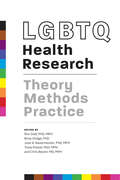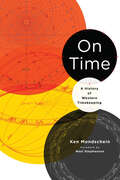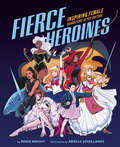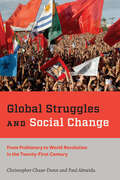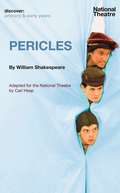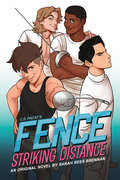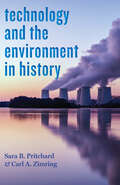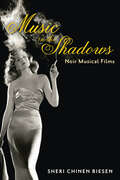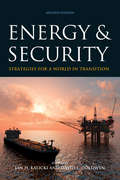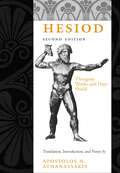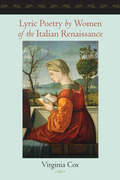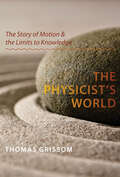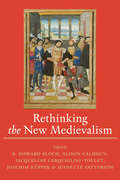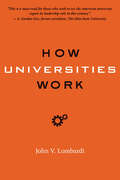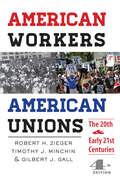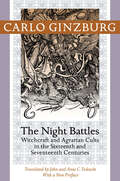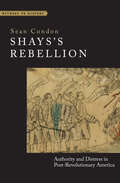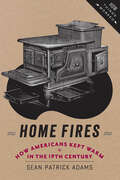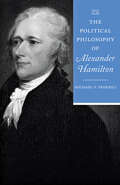- Table View
- List View
LGBTQ Health Research: Theory, Methods, Practice
by Ron Stall Brian Dodge José A. Bauermeister Tonia Poteat Chris BeyrerOver the last 30 years, the health needs of lesbian, gay, bisexual, transgender, and queer Americans have become increasingly recognized, in particular for the ways in which they are distinct from those typically assessed and addressed in society. Universities and researchers are paying greater attention to LGBTQ public health issues and how they might adapt existing methods to research marginalized communities, but—until now—there has been no authoritative resource to guide their education or practice. Developed for graduate students in public health and health sciences—but perfect for anyone interested in this topic—this book will fill that gap and provide the necessary public health tools to teach about and study LGBTQ populations effectively. Divided into three sections and edited by top scholars, LGBTQ Health Research explains research methods important to descriptive epidemiology that are needed to document health disparities among LGBTQ populations. The book also examines research methods that help explain the driving forces of these disparities. Focusing on real-world experience in developing and testing interventions to mitigate health disparities in LGBTQ populations, it also breaks down issues that challenge the direct application of standard research methods with these communities, including those related to sampling, measurement, choice of theoretical variables to explain the distribution of health and illness, cultural competence in intervention design, and community participation.Promoting the creation and diffusion of effective interventions, the book takes a holistic approach to address longstanding research gaps regarding important marginalized communities. It also documents profound health disparities in many LBGTQ populations across a wide range of health conditions and explains why future development of the field must be based on inclusive science and rigorous research methods. LGBTQ Health Research is an essential textbook for any courses that deal with the intersection of marginalization, health, sexuality, and gender.Contributors: José A. Bauermeister, Chris Beyrer, Kerith Conron, Brian Dodge, Rita Dwan, Stephen L. Forssell, Peter Gamache, Gary W. Harper, Mark L. Hatzenbuehler, Colleen Hoff, Carl Latkin, Ilan H. Meyer, Robin Lin Miller, Angulique Y. Outlaw, Christopher Owens, Tonia Poteat, Erin Riley, Joshua Rosenberger, Ayden I. Scheim, Shauna Stahlman, Randall Sell, Ron Stall, Rob Stephenson, Rachel Strecher, Ryan C. Tingler, Karin E. Tobin, Ronald O. Valdiserri, and Richard J. Wolitski
LGBTQ Health Research: Theory, Methods, Practice
by Ron Stall PHD, MPH, et al.Over the last 30 years, the health needs of lesbian, gay, bisexual, transgender, and queer Americans have become increasingly recognized, in particular for the ways in which they are distinct from those typically assessed and addressed in society. Universities and researchers are paying greater attention to LGBTQ public health issues and how they might adapt existing methods to research marginalized communities, but—until now—there has been no authoritative resource to guide their education or practice. Developed for graduate students in public health and health sciences—but perfect for anyone interested in this topic—this book will fill that gap and provide the necessary public health tools to teach about and study LGBTQ populations effectively. Divided into three sections and edited by top scholars, LGBTQ Health Research explains research methods important to descriptive epidemiology that are needed to document health disparities among LGBTQ populations. The book also examines research methods that help explain the driving forces of these disparities. Focusing on real-world experience in developing and testing interventions to mitigate health disparities in LGBTQ populations, it also breaks down issues that challenge the direct application of standard research methods with these communities, including those related to sampling, measurement, choice of theoretical variables to explain the distribution of health and illness, cultural competence in intervention design, and community participation.Promoting the creation and diffusion of effective interventions, the book takes a holistic approach to address longstanding research gaps regarding important marginalized communities. It also documents profound health disparities in many LBGTQ populations across a wide range of health conditions and explains why future development of the field must be based on inclusive science and rigorous research methods. LGBTQ Health Research is an essential textbook for any courses that deal with the intersection of marginalization, health, sexuality, and gender.Contributors: José A. Bauermeister, Chris Beyrer, Kerith Conron, Brian Dodge, Rita Dwan, Stephen L. Forssell, Peter Gamache, Gary W. Harper, Mark L. Hatzenbuehler, Colleen Hoff, Carl Latkin, Ilan H. Meyer, Robin Lin Miller, Angulique Y. Outlaw, Christopher Owens, Tonia Poteat, Erin Riley, Joshua Rosenberger, Ayden I. Scheim, Shauna Stahlman, Randall Sell, Ron Stall, Rob Stephenson, Rachel Strecher, Ryan C. Tingler, Karin E. Tobin, Ronald O. Valdiserri, and Richard J. Wolitski
On Time: A History of Western Timekeeping
by Kenneth C. MondscheinWestern culture has been obsessed with regulating society by the precise, accurate measurement of time since the Middle Ages. In On Time, Ken Mondschein explores the paired development of concepts and technologies of timekeeping with human thought. Without clocks, he argues, the modern world as we know it would not exist. From the astronomical timekeeping of the ancient world to the tower clocks of the Middle Ages to the seagoing chronometer, the quartz watch, and the atomic clock, greater precision and accuracy have had profound effects on human society—which, in turn, has driven the quest for further precision and accuracy. This quest toward automation—which gave rise to the Gregorian calendar, the factory clock, and even the near-disastrous Y2K bug—has led to profound social repercussions and driven the creation of the modern scientific mindset. Surveying the evolution of the clock from prehistory to the twenty-first century, Mondschein explains how both the technology and the philosophy behind Western timekeeping regimes came to take over the entire world. On Time is a story of thinkers, philosophers, and scientists, and of the thousand decisions that continue to shape our daily lives.
On Time: A History of Western Timekeeping
by Kenneth C. MondscheinWestern culture has been obsessed with regulating society by the precise, accurate measurement of time since the Middle Ages. In On Time, Ken Mondschein explores the paired development of concepts and technologies of timekeeping with human thought. Without clocks, he argues, the modern world as we know it would not exist. From the astronomical timekeeping of the ancient world to the tower clocks of the Middle Ages to the seagoing chronometer, the quartz watch, and the atomic clock, greater precision and accuracy have had profound effects on human society—which, in turn, has driven the quest for further precision and accuracy. This quest toward automation—which gave rise to the Gregorian calendar, the factory clock, and even the near-disastrous Y2K bug—has led to profound social repercussions and driven the creation of the modern scientific mindset. Surveying the evolution of the clock from prehistory to the twenty-first century, Mondschein explains how both the technology and the philosophy behind Western timekeeping regimes came to take over the entire world. On Time is a story of thinkers, philosophers, and scientists, and of the thousand decisions that continue to shape our daily lives.
Fierce Heroines: Inspiring Female Characters in Pop Culture
by Rosie KnightThis inclusive and diverse anthology gathers seventy-five empowering heroines -- perfect for pop culture fans of all ages.Whether it's anime, movies, video games, comics, books, or television series, pop culture is full of female characters that inspire and encourage us to be brave, kind, thoughtful, and powerful. With comic-book inspired illustrations, character profiles and origins, and fun facts throughout, Fierce Heroines is the ultimate feminist tribute to pop culture's most amazing female characters.Now fans can learn about 75 diverse classic and contemporary heroines that are empowering girls and women all over the world like:Anime & Manga: San (Princess Mononoke), Usagi Tsukino (Sailor Moon), Tohru Honda (Fruits Basket), Bulma (Dragon Ball), Kagome Higurashi (InuYasha), and Ochako Uraraka (My Hero Academia)Cartoons: She-Ra (She-Ra and the Princess of Power), Susie Carmichael (Rugrats), Carmen Sandiego (Carmen Sandiego), Toph Beifong (Avatar: the Last Airbender), and Garnet (Steven Universe)Comics: Doreen Green (Squirrel Girl), Ripley (Lumberjanes), Goldie Vance (Goldie Vance), Marjane Satrapi (Persepolis), Leah Dwyer (Jem and the Holograms), and Barbara Gordon (Birds of Prey)Movies: Hermoine (Harry Potter), Moana (Moana), Jesminder Bhamra (Bend It Like Beckham), Valkyrie (Thor: Ragnarok), Leia Organa (Star Wars), and Meg Murry (A Wrinkle in Time)Television: The 13th Doctor (Doctor Who), Andi Mack (Andi Mack), Eleven (Stranger Things), Mel, Maggie & Macy (Charmed), Becky Jackson (Glee), McKeyla, Adrienne, Bryden & Camryn (Project Mc²)Video Games: Lara Croft (Tomb Raider), Tifa Lockhart (Final Fantasy VII), Tracer (Overwatch), Zelda (The Legend of Zelda), Samus Aran (Metroid), and Mina (Battle Chef Brigade)A perfect gift for girls, women, and fans of all kinds, Fierce Heroines is a powerful, inspirational reminder that anyone can be a heroine!
Global Struggles and Social Change: From Prehistory to World Revolution in the Twenty-First Century
by Christopher Chase-Dunn Paul AlmeidaIn the early decades of the twenty-first century, an international movement to slow the pace of climate change mushroomed across the globe. The self-proclaimed Climate Justice movement urges immediate action to reduce carbon emissions and calls for the adoption of bold new policies to address global warming before irreversible and catastrophic damage threatens the habitability of the planet. On another front, since the 1980s, multiple waves of resistance have occurred around the world against the uneven transition from state-led development to the neoliberal globalization project. Both Climate Justice and Anti-Austerity movements represent the urgency of understanding how global change affects the ability of citizens around the world to mobilize and protect themselves from planetary warming and the loss of social protections granted in earlier eras.In Global Struggles and Social Change, Christopher Chase-Dunn and Paul Almeida explore how global change stimulates the formation and shape of such movements. Contending that large-scale economic shifts condition the pattern of social movement mobilizations around the world, the authors trace these trends back to premodern societies, revealing how severe disruptions of indigenous communities led to innovative collective actions throughout history. Drawing on historical case studies, world system and protest event analysis, and social networks, they also examine the influence of global change processes on local, national, and transnational social movements and explain how in turn these movements shape institutional shifts. Touching on hot-button topics, including global warming, immigrant rights protests, the rise of right-wing populism, and the 2008 financial crisis, the book also explores a broad range of premodern social movements from indigenous people in the Americas, Mesopotamia, and China. The authors pay special attention to periods of disruption and external threats, as well as the role of elites, emotions, charisma, and religion or spirituality in shaping protest movements. Providing sweeping coverage, Global Struggles and Social Change is perfect for students and anyone interested in globalization, international and comparative politics, political sociology, and communication studies.
Global Struggles and Social Change: From Prehistory to World Revolution in the Twenty-First Century
by Christopher Chase-Dunn Paul AlmeidaIn the early decades of the twenty-first century, an international movement to slow the pace of climate change mushroomed across the globe. The self-proclaimed Climate Justice movement urges immediate action to reduce carbon emissions and calls for the adoption of bold new policies to address global warming before irreversible and catastrophic damage threatens the habitability of the planet. On another front, since the 1980s, multiple waves of resistance have occurred around the world against the uneven transition from state-led development to the neoliberal globalization project. Both Climate Justice and Anti-Austerity movements represent the urgency of understanding how global change affects the ability of citizens around the world to mobilize and protect themselves from planetary warming and the loss of social protections granted in earlier eras.In Global Struggles and Social Change, Christopher Chase-Dunn and Paul Almeida explore how global change stimulates the formation and shape of such movements. Contending that large-scale economic shifts condition the pattern of social movement mobilizations around the world, the authors trace these trends back to premodern societies, revealing how severe disruptions of indigenous communities led to innovative collective actions throughout history. Drawing on historical case studies, world system and protest event analysis, and social networks, they also examine the influence of global change processes on local, national, and transnational social movements and explain how in turn these movements shape institutional shifts. Touching on hot-button topics, including global warming, immigrant rights protests, the rise of right-wing populism, and the 2008 financial crisis, the book also explores a broad range of premodern social movements from indigenous people in the Americas, Mesopotamia, and China. The authors pay special attention to periods of disruption and external threats, as well as the role of elites, emotions, charisma, and religion or spirituality in shaping protest movements. Providing sweeping coverage, Global Struggles and Social Change is perfect for students and anyone interested in globalization, international and comparative politics, political sociology, and communication studies.
Pericles: With The Story Of The Prince Of Tyre... . (Oberon Plays for Young People)
by William Shakespeare Carl HeapAdapted for The National Theatre by Carl Heap 'The world to me is like a lasting storm' An exciting tale of shipwrecks and magic, villains and heroes, and a child's fight for survival in a foreign land. Join Pericles on his epic travels of adventure and discovery. Primary Classics, produced by the National Theatre's Discover programme, aims to introduce children aged 7 to 11 to Shakespeare. This version of Pericles, adapted and originally directed by Carl Heap, preserves the core of Shakespeare's plot, retains the original langauge, yet is presented very much with the target age group in mind. Carl Heap's introduction will help readers, teachers and practitioners alike to imagine or produce their own version.
Fence: Striking Distance
by Sarah Rees BrennanThe boys of Kings Row bout with drama, rivalry, and romance in this original YA novel by The New York Times bestselling author Sarah Rees Brennan -- inspired by the award-nominated comic series by C.S. Pacat and Johanna The Mad.Sixteen-year-old Nicholas Cox is the illegitimate son of a retired fencing champion who dreams of getting the proper training he could never afford. After earning a place on the elite Kings Row fencing team, Nicholas must prove himself to his rival, Seiji Katayma, and navigate the clashes, friendships, and relationships between his teammates on the road to state championships -- where Nicholas might finally have the chance to spar with his golden-boy half-brother.Coach Williams decides to take advantage of the boys' morale after a recent victory and assigns them a course of team building exercises to further deepen their bonds. It takes a shoplifting scandal, a couple of moonlit forest strolls, several hilariously bad dates, and a whole lot of introspection for the team to realize they are stronger together than they could ever be apart. The first installment of this enticing original YA novel series by Sarah Rees Brennan, rich with casual diversity and queer self-discovery, explores never-before-seen drama inspired by C.S. Pacat's critically acclaimed Fence comic series and boasts original cover and interior art by Johanna The Mad.Text and Illustration copyright: © 2020 BOOM! StudiosFence(TM) and © 2020 C.S. Pacat
An Introduction to the US Health Care Industry: Balancing Care, Cost, and Access
by David S. GuzickFor decades, the United States has been faced with a puzzling problem: Despite spending much more money per capita on health care than any other developed nation, its population suffers from notoriously poorer health. In comparison with 10 other high-income nations, in fact, the US has the lowest life expectancy at birth, the highest rates of infant and neonatal mortality, and the most inequitable access to physicians when adjusted for need. In An Introduction to the US Health Care Industry, Dr. David S. Guzick takes an in-depth look at this troubling issue. Bringing to bear his unique background as a physician, economist, former University of Rochester medical school dean, and former president of the University of Florida Health System, Dr. Guzick shows that what we commonly refer to as the US health care "system" is actually an industry forged by a unique collection of self-interested and disjointed stakeholders. He argues that the assumptions underlying well-functioning markets do not align with health care. The resulting market imperfections, combined with entrenched industry stakeholders, have led to a significant imbalance of care, cost, and access.Using a nontechnical framework, Dr. Guzick introduces readers to the economic principles behind the function—and dysfunction—of our health care industry. He shows how the market-based approach could be expected to remedy these problems while detailing the realities of imperfections, regulations, and wealth inequality on those functions. He also analyzes how this industry developed, presenting the conceptual underpinnings of the health care industry while detailing its history and tracing the creation and entrenchment of the current federation of key stakeholders—government, insurance companies, hospitals, doctors, employers, and drug and device manufacturers. In the final section of the book, Dr. Guzick looks to the future, describing the prevention, innovation, and alternative financing models that could help to rebalance the priorities of care, cost, and access that Americans need.
An Introduction to the US Health Care Industry: Balancing Care, Cost, and Access
by David S. GuzickFor decades, the United States has been faced with a puzzling problem: Despite spending much more money per capita on health care than any other developed nation, its population suffers from notoriously poorer health. In comparison with 10 other high-income nations, in fact, the US has the lowest life expectancy at birth, the highest rates of infant and neonatal mortality, and the most inequitable access to physicians when adjusted for need. In An Introduction to the US Health Care Industry, Dr. David S. Guzick takes an in-depth look at this troubling issue. Bringing to bear his unique background as a physician, economist, former University of Rochester medical school dean, and former president of the University of Florida Health System, Dr. Guzick shows that what we commonly refer to as the US health care "system" is actually an industry forged by a unique collection of self-interested and disjointed stakeholders. He argues that the assumptions underlying well-functioning markets do not align with health care. The resulting market imperfections, combined with entrenched industry stakeholders, have led to a significant imbalance of care, cost, and access.Using a nontechnical framework, Dr. Guzick introduces readers to the economic principles behind the function—and dysfunction—of our health care industry. He shows how the market-based approach could be expected to remedy these problems while detailing the realities of imperfections, regulations, and wealth inequality on those functions. He also analyzes how this industry developed, presenting the conceptual underpinnings of the health care industry while detailing its history and tracing the creation and entrenchment of the current federation of key stakeholders—government, insurance companies, hospitals, doctors, employers, and drug and device manufacturers. In the final section of the book, Dr. Guzick looks to the future, describing the prevention, innovation, and alternative financing models that could help to rebalance the priorities of care, cost, and access that Americans need.
Technology and the Environment in History: Nature and Technology in History (Technology in Motion)
by Sara B. Pritchard Carl A. ZimringToday's scientists, policymakers, and citizens are all confronted by numerous dilemmas at the nexus of technology and the environment. Every day seems to bring new worries about the dangers posed by carcinogens, "superbugs," energy crises, invasive species, genetically modified organisms, groundwater contamination, failing infrastructure, and other troubling issues. In Technology and the Environment in History, Sara B. Pritchard and Carl A. Zimring adopt an analytical approach to explore current research at the intersection of environmental history and the history of technology—an emerging field known as envirotech. Technology and the Environment in History They discuss the important topics, historical processes, and scholarly concerns that have emerged from recent work in thinking about envirotech. Each chapter focuses on a different urgent topic: • Food and Food Systems: How humans have manipulated organisms and ecosystems to produce nutrients for societies throughout history.• Industrialization: How environmental processes have constrained industrialization and required shifts in the relationships between human and nonhuman nature.• Discards: What we can learn from the multifaceted forms, complex histories, and unexpected possibilities of waste.• Disasters: How disaster, which the authors argue is common in the industrialized world, exposes the fallacy of tidy divisions among nature, technology, and society.• Body: How bodies reveal the porous boundaries among technology, the environment, and the human.• Sensescapes: How environmental and technological change have reshaped humans' (and potentially nonhumans') sensory experiences over time.Using five concepts to understand the historical relationships between technology and the environment—porosity, systems, hybridity, biopolitics, and environmental justice—Pritchard and Zimring propose a chronology of key processes, moments, and periodization in the history of technology and the environment. Ultimately, they assert, envirotechnical perspectives help us engage with the surrounding world in ways that are, we hope, more sustainable and just for both humanity and the planet. Aimed at students and scholars new to environmental history, the history of technology, and their nexus, this impressive synthesis looks outward and forward—identifying promising areas in more formative stages of intellectual development and current synergies with related areas that have emerged in the past few years, including environmental anthropology, discard studies, and posthumanism.
Technology and the Environment in History: Nature and Technology in History (Technology in Motion)
by Sara B. Pritchard Carl A. ZimringToday's scientists, policymakers, and citizens are all confronted by numerous dilemmas at the nexus of technology and the environment. Every day seems to bring new worries about the dangers posed by carcinogens, "superbugs," energy crises, invasive species, genetically modified organisms, groundwater contamination, failing infrastructure, and other troubling issues. In Technology and the Environment in History, Sara B. Pritchard and Carl A. Zimring adopt an analytical approach to explore current research at the intersection of environmental history and the history of technology—an emerging field known as envirotech. Technology and the Environment in History They discuss the important topics, historical processes, and scholarly concerns that have emerged from recent work in thinking about envirotech. Each chapter focuses on a different urgent topic: • Food and Food Systems: How humans have manipulated organisms and ecosystems to produce nutrients for societies throughout history.• Industrialization: How environmental processes have constrained industrialization and required shifts in the relationships between human and nonhuman nature.• Discards: What we can learn from the multifaceted forms, complex histories, and unexpected possibilities of waste.• Disasters: How disaster, which the authors argue is common in the industrialized world, exposes the fallacy of tidy divisions among nature, technology, and society.• Body: How bodies reveal the porous boundaries among technology, the environment, and the human.• Sensescapes: How environmental and technological change have reshaped humans' (and potentially nonhumans') sensory experiences over time.Using five concepts to understand the historical relationships between technology and the environment—porosity, systems, hybridity, biopolitics, and environmental justice—Pritchard and Zimring propose a chronology of key processes, moments, and periodization in the history of technology and the environment. Ultimately, they assert, envirotechnical perspectives help us engage with the surrounding world in ways that are, we hope, more sustainable and just for both humanity and the planet. Aimed at students and scholars new to environmental history, the history of technology, and their nexus, this impressive synthesis looks outward and forward—identifying promising areas in more formative stages of intellectual development and current synergies with related areas that have emerged in the past few years, including environmental anthropology, discard studies, and posthumanism.
Music in the Shadows: Noir Musical Films
by Sheri Chinen BiesenSmoke. Shadows. Moody strains of jazz. Welcome to the world of "noir musical" films, where tormented antiheroes and hard-boiled musicians battle obsession and struggle with their music and ill-fated love triangles. Sultry divas dance and sing the blues in shrouded nightclubs. Romantic intrigue clashes with backstage careers. In her pioneering study, Music in the Shadows, film noir expert Sheri Chinen Biesen explores musical films that use film noir style and bluesy strains of jazz to inhabit a disturbing underworld and reveal the dark side of fame and the American Dream. While noir musical films like A Star Is Born include musical performances, their bleak tone and expressionistic aesthetic more closely resemble the visual style of film noir. Their narratives unfold behind a stark noir lens: distorted, erratic angles and imbalanced hand-held shots allow the audience to experience a tortured, disillusioned perspective.While many musicals glamorize the quest for the spotlight in Hollywood's star factory, brooding noir musical films such as Blues in the Night, Gilda, The Red Shoes, West Side Story, and Round Midnight stretch the boundaries of film noir and the musical as film genres collide. Deep shadows, dim lighting, and visual composition evoke moodiness, cynicism, pessimism, and subjective psychological points of view.As in her earlier study of film noir, Blackout: World War II and the Origins of Film Noir, Biesen draws on extensive primary research in studio archives to situate her examination within a historical, industrial, and cultural context.
Energy and Security: Strategies for a World in Transition
by Jan H. Kalicki David L. GoldwynThe second, completely updated edition of this widely read and respected guide is the most authoritative survey available on the perennial question of energy security. Energy and Security gathers today's topmost foreign policy and energy experts and leaders to assess how the United States can integrate its energy and national security interests. This edition offers fresh analysis and insight into • Fundamental shifts in the global energy balance • The revolution in shale gas and oil • New energy frontiers, from ultra deepwater to the Arctic • The rising agenda of safety concerns across the energy complex • Energy poverty • Infrastructure for modernizing power grids • Climate security in the current political and economic environmentThe contributors offer a lively discussion of the challenges and opportunities presented by these changes and how they affect national security and regional politics around the globe.
Hesiod: Theogony, Works and Days, Shield
by Apostolos N. HesiodHesiod belongs to the transitional period in Greek civilization between the oral tradition and the introduction of a written alphabet. His two major surviving works, the Theogony and the Works and Days, address the divine and the mundane, respectively. The Theogony traces the origins of the Greek gods and recounts the events surrounding the crowning of Zeus as their king. A manual of moral instruction in verse, the Works and Days was addressed to farmers and peasants.Introducing his celebrated translations of these two poems and of the Shield, a very ancient poem of disputed authorship, Apostolos Athanassakis positions Hesiod simultaneously as a philosopher-poet, a bard with deep roots in the culture of his native Boeotia, and the heir to a long tradition of Hellenic poetry. For this eagerly anticipated revised edition, Athanassakis has provided an expanded introduction on Hesiod and his work, subtly amended his faithful translations, significantly augmented the notes and index, and updated the bibliography. Already a classic, Hesiod: Theogony, Works and Days, Shield is now more valuable than ever for students of Greek mythology and literature.
Lyric Poetry by Women of the Italian Renaissance
by Virginia CoxLyric Poetry by Women of the Italian Renaissance is the first modern anthology of verse by Italian women of this period to give a full representation of the richness and diversity of their output. Although familiar authors such as Vittoria Colonna, Gaspara Stampa, and Veronica Gambara are well represented, half of the fifty-four poets featured are unknown even to many specialists. Especially noteworthy is an extensive selection of verse from the period following 1560, which has received little or no critical attention. This later, strikingly experimental, proto-Baroque tradition of verse is reconstructed here for the first time.Virginia Cox creates both a scholarly teaching resource and a collection of poetry accessible to general readers with no previous knowledge of the Italian poetic tradition. Each poem is presented in its original language, accompanied by a translation and commentary. An introduction traces the history of Italian lyric poetry from the fifteenth to the seventeenth century. Cox also provides a guide to meter, rhythm, and rhyme, as well as a glossary of rhetorical terms and a biographical dictionary of authors.Organized thematically, this book offers poems about love, religion, and politics; verse addressed to patrons, friends, family, and places; and polemical and correspondence verse. Four languages are represented: Greek, Latin, literary Tuscan of various levels of standardization, and the stylized rustic dialect of pavan. The volume contains more than 200 poems, of which about a quarter have never before been published in a modern edition and more than a third have not previously been available in English translation."Exhaustive and insightful... This is an amazing book, a major achievement in the field of women's studies."—Renaissance Quarterly, reviewing Women’s Writing in Italy, 1400–1650
The Physicist's World: The Story of Motion and the Limits to Knowledge
by Thomas GrissomHow do students learn about physics without picking up a 1,000-page textbook chock-full of complicated equations? The Physicist’s World is the answer. Here, Thomas Grissom explains clearly and succinctly what physics really is: the science of understanding how everything in the universe moves.From the earliest efforts by Presocratic philosophers contemplating motion to the principal developments of physics through the end of the twentieth century, Grissom tells the unfolding story of our attempt to quantify the material world and to conceptualize the nature of physical laws. Through the centuries, questions about why things move proved to be unanswerable in any absolute, satisfying way. Instead the question became how things move, a direction of thought that led to the rise of modern science. Physics emerged as a mathematical description of the motion of matter and energy, a description believed to be complete and exact, limited only by the precision of measurement. Grissom shows that in one of the great intellectual ironies, advancements in twentieth-century physics affirmed instead that this quantitative theory was capable of discovering its own limits. There is only so much that physics can reveal about the world. This is physics for the thinking person, especially students who enjoy learning concepts, histories, and interpretations without becoming mired in complex mathematical detail. A concise survey of the field of physics, Grissom’s book offers students and professionals alike a unique perspective on what physicists do, how physics is done, and how physicists view the world.
Rethinking the New Medievalism
by R. Howard Bloch Alison Calhoun Jacqueline Cerquiglini-Toulet Joachim Küpper Jeanette PattersonIn the early 1990s, Stephen Nichols introduced the term "new medievalism" to describe an alternative to the traditional philological approach to the study of the romantic texts in the medieval period. While the old approach focused on formal aspects of language, this new approach was historicist and moved beyond a narrow focus on language to examine the broader social and cultural contexts in which literary works were composed and disseminated. Within the field, this transformation of medieval studies was as important as the genetic revolution to the study of biology and has had an enormous influence on the study of medieval literature. Rethinking the New Medievalism offers both a historical account of the movement and its achievements while indicating—in Nichols’s innovative spirit—still newer directions for medieval studies.The essays deal with questions of authorship, theology, and material philology and are written by members of a wide philological and critical circle that Nichols nourished for forty years. Daniel Heller-Roazen’s essay, for example, demonstrates the conjunction of the old philology and the new. In a close examination of the history of the words used for maritime raiders from Ancient Greece to the present (pirate, plunderer, bandit), Roazen draws a fine line between lawlessness and lawfulness, between judicial action and war, between war and public policy. Other contributors include Jack Abecassis, Marina Brownlee, Jacqueline Cerquiglini-Toulet, Andreas Kablitz, and Ursula Peters.
How Universities Work (Higher Ed Leadership Essentials)
by John V. LombardiWitty and insightful, How Universities Work is destined to be an essential handbook for anyone wanting to understand universities in the United States. John V. Lombardi gives readers an insider’s view of the academy, describing the structure, logic, dynamics, and operational styles of both public and private institutions of higher education. Lombardi defines and describes all the bits and pieces that compose a university with remarkable economy—from budgeting systems to tenure, from the library to the athletic field. Although focused on research universities, much of the discussion applies to other types of post-secondary institutions. Ideal for students, this book will form a solid foundation for courses in higher education, but it will also be a welcome addition to faculty and administrators’ personal libraries.
American Workers, American Unions: The Twentieth and Early Twenty-First Centuries (The American Moment)
by Robert H. Zieger Timothy J. Minchin Gilbert J. GallHighly acclaimed and widely read since its first publication in 1986, American Workers, American Unions provides a concise and compelling history of American workers and their unions in the twentieth century and the first decade of the twenty-first. Taking into account recent important work on the 1970s and the Reagan revolution, the fourth edition newly considers the stagflation issue, the rise of globalization and big box retailing, the failure of Congress to pass legislation supporting the right of public employees to collective bargaining, the defeat in Congress of legislation to revise the National Labor Relations Act, the emasculation of the Humphrey-Hawkins Act, and the changing dynamics of blue-collar politics. In addition to important new information on the 1970s and 1980s, the fourth edition contains a completely new final chapter. Largely written by Timothy J. Minchin, this chapter provides a rare survey of American workers and their unions between 9/11 and the 2012 presidential election. Gilbert J. Gall presents new information on government workers and their recent battles to defend workplace rights.
The Night Battles: Witchcraft and Agrarian Cults in the Sixteenth and Seventeenth Centuries
by Carlo GinzburgBased on research in the Inquisitorial archives of Northern Italy, The Night Battles recounts the story of a peasant fertility cult centered on the benandanti, literally, "good walkers." These men and women described fighting extraordinary ritual battles against witches and wizards in order to protect their harvests. While their bodies slept, the souls of the benandanti were able to fly into the night sky to engage in epic spiritual combat for the good of the village. Carlo Ginzburg looks at how the Inquisition's officers interpreted these tales to support their world view that the peasants were in fact practicing sorcery. The result of this cultural clash, which lasted for more than a century, was the slow metamorphosis of the benandanti into the Inquisition's mortal enemies—witches.Relying upon this exceptionally well-documented case study, Ginzburg argues that a similar transformation of attitudes—perceiving folk beliefs as diabolical witchcraft—took place all over Europe and spread to the New World. In his new preface, Ginzburg reflects on the interplay of chance and discovery, as well as on the relationship between anomalous cases and historical generalizations.
Shays's Rebellion: Authority and Distress in Post-Revolutionary America (Witness to History)
by Sean CondonThroughout the late summer and fall of 1786, farmers in central and western Massachusetts organized themselves into armed groups to protest against established authority and aggressive creditors. Calling themselves "regulators" or the "voice of the people," these crowds attempted to pressure the state government to lower taxes and provide relief to debtors by using some of the same methods employed against British authority a decade earlier. From the perspective of men of wealth and station, these farmers threatened the foundations of society: property rights and their protection in courts and legislature.In this concise and compelling account of the uprising that came to be known as Shays’s Rebellion, Sean Condon describes the economic difficulties facing both private citizens and public officials in newly independent Massachusetts. He explains the state government policy that precipitated the farmers’ revolt, details the machinery of tax and debt collection in the 1780s, and provides readers with a vivid example of how the establishment of a republican form of government shifted the boundaries of dissent and organized protest. Underscoring both the fragility and the resilience of government authority in the nascent republic, the uprising and its aftermath had repercussions far beyond western Massachusetts; ultimately, it shaped the framing and ratification of the U.S. Constitution, which in turn ushered in a new, stronger, and property-friendly federal government. A masterful telling of a complicated story, Shays’s Rebellion is aimed at scholars and students of American history.
Home Fires: How Americans Kept Warm in the Nineteenth Century (How Things Worked)
by Sean Patrick AdamsHome Fires tells the fascinating story of how changes in home heating over the nineteenth century spurred the growth of networks that helped remake American society. Sean Patrick Adams reconstructs the ways in which the "industrial hearth" appeared in American cities, the methods that entrepreneurs in home heating markets used to convince consumers that their product designs and fuel choices were superior, and how elite, middle-class, and poor Americans responded to these overtures.Adams depicts the problem of dwindling supplies of firewood and the search for alternatives; the hazards of cutting, digging, and drilling in the name of home heating; the trouble and expense of moving materials from place to place; the rise of steam power; the growth of an industrial economy; and questions of economic efficiency, at both the individual household and the regional level. Home Fires makes it clear that debates over energy sources, energy policy, and company profit margins have been around a long time.The challenge of staying warm in the industrializing North becomes a window into the complex world of energy transitions, economic change, and emerging consumerism. Readers will understand the struggles of urban families as they sought to adapt to the ever-changing nineteenth-century industrial landscape. This perspective allows a unique view of the development of an industrial society not just from the ground up but from the hearth up.
The Political Philosophy of Alexander Hamilton (The Political Philosophy of the American Founders)
by Michael P. FedericiAmerica’s first treasury secretary and one of the three authors of the Federalist Papers, Alexander Hamilton stands as one of the nation’s important early statesmen. Michael P. Federici places this Founding Father among the country’s original political philosophers as well.Hamilton remains something of an enigma. Conservatives and liberals both claim him, and in his writings one can find material to support the positions of either camp. Taking a balanced and objective approach, Federici sorts through the written and historical record to reveal Hamilton’s philosophy as the synthetic product of a well-read and pragmatic figure whose intellectual genealogy drew on Classical thinkers such as Cicero and Plutarch, Christian theologians, and Enlightenment philosophers, including Hume and Montesquieu. In evaluating the thought of this republican and would-be empire builder, Federici explains that the apparent contradictions found in the Federalist Papers and other examples of Hamilton’s writings reflect both his practical engagement with debates over the French Revolution, capital expansion, commercialism, and other large issues of his time, and his search for a balance between central authority and federalism in the embryonic American government. This book challenges the view of Hamilton as a monarchist and shows him instead to be a strong advocate of American constitutionalism.Devoted to the whole of Hamilton’s political writing, this accessible and teachable analysis makes clear the enormous influence Hamilton had on the development of American political and economic institutions and policies.
